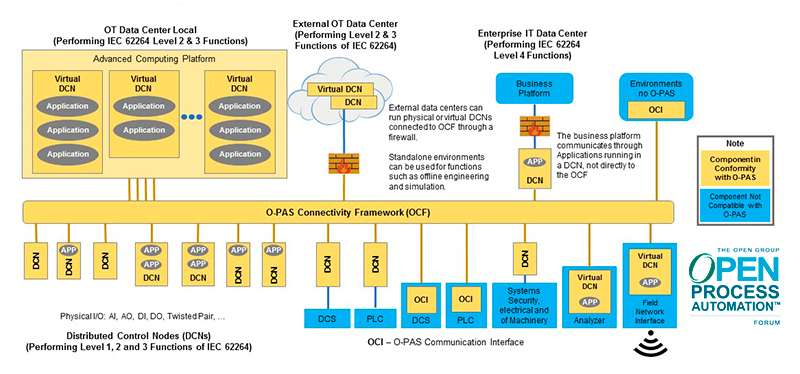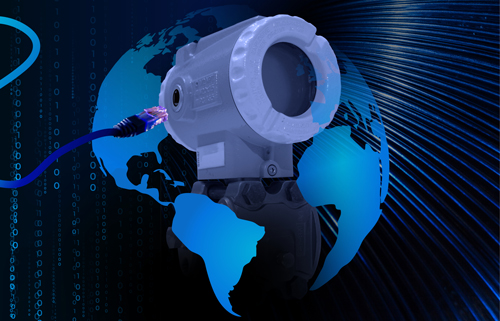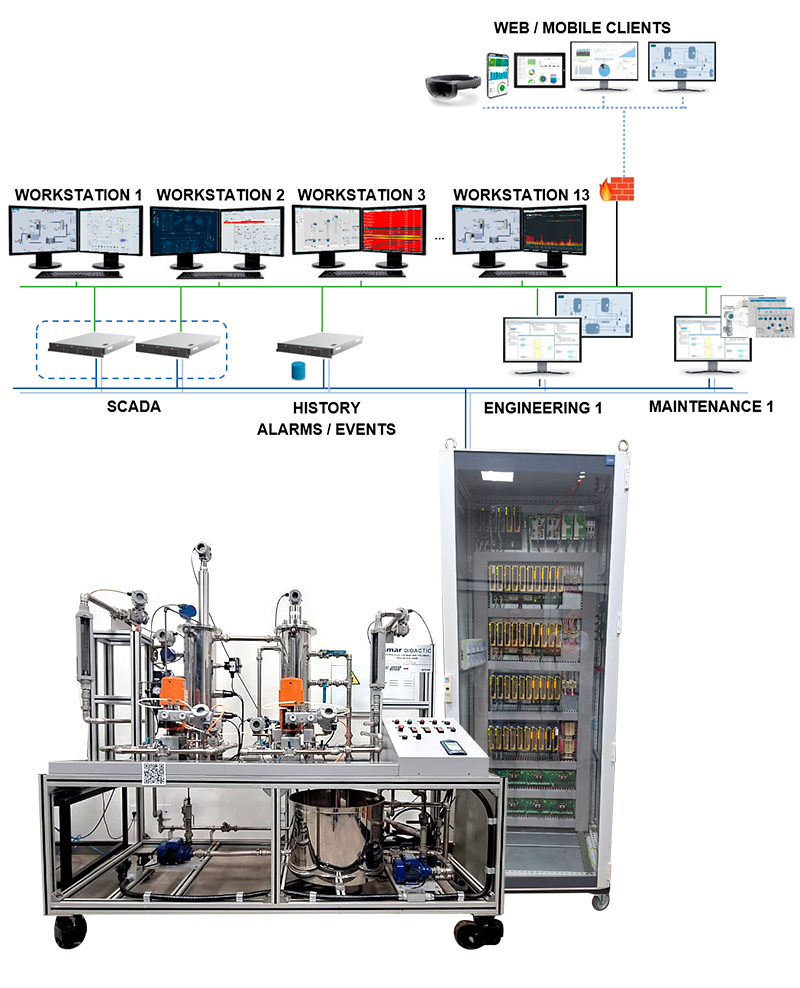
O-PAS Integrated Operations Center
.jpg)
Nova Smar's O-PAS Integrated Operations Center is a product designed to allow its users direct and complete contact with the latest industrial Process Automation technologies, in an environment very similar to that of a modern industrial plant.
This solution includes a pilot process plant with sensors and final control elements interconnected to a complete automation and operation system that includes the most current and promising technologies in the area such as O-PAS, Open Process Automation Standard, and Ethernet APL, Advanced Physical Layer.
Visualizing the future
Industrial automation plays a strategic role in current processing plants, as it has a strong impact on their efficiency and consequent competitiveness, in a global market that is evolving at an increasingly rapid pace.
The most advanced industrial automation solutions must allow monitoring and management of industrial production and processing activities effectively and uninterruptedly. Therefore, an information management platform with high reliability, availability and performance, which accurately displays large volumes of sensor data while enabling remote collaboration, is essential for fast and effective decision-making in scenarios where minutes count more and more.

O-PAS Integrated Operations Center offers customers a practical and engaging experience with the latest and most sophisticated technologies and automation solutions for control, operations and management of industrial processes, including a pilot plant, sensors, instruments, elements control ends and controllers connected to a true operations room. In other words, it is a product capable of faithfully simulating countless measurement, control, engineering process, maintenance, operation and management scenarios in an industry
O-PAS Overview
O-PAS, Open Process Automation Standard, is the standard that brings together best practices, technologies and established automation standards, as well as established IT technologies for innovative use in the industrial world. This standard was released and continues to be improved by the Open Process Automation Forum (OPAF), part of The Open Group ( www.opengroup.org ). The standard is designed to create a more flexible, open and interoperable automation environment, and, at the same time, more secure, reliable and quickly managed and automated.
Some of the benefits of O-PAS for end users include greater flexibility and agility for new implementations, expansions and modifications of automation and operation systems, thus allowing their solutions to be continuously customized according to the specific needs of each plant; a significant cost reduction in all these activities as a result of healthier competition; greater security through the adoption of the best security standards, technologies and practices, already incorporated into the O-PAS specifications, which reduce the risks of cyberattacks and security failures, guaranteeing the integrity of industrial processes; and also simplified, simpler and more efficient maintenance, allowing, for example, the replacement of individual components in a fully or partially automated way and without affecting the system as a whole.

This results in greater operational flexibility and better ability to adapt to continuous changes in the production environment, quickly, cost-effectively and safely.
Hardware and Software Vendors can also benefit from having access to an expanded market given the openness of O-PAS in terms of using hardware and software components from any manufacturer in any system. Such companies will be able to specialize and seek continuous innovation as they seek to create more effective and interoperable solutions according to user demands, as well as having opportunities to establish strategic partnerships, where companies with different specialties come together and create innovative solutions. more efficiently and that can benefit a greater number of users
And the benefits for the market don’t stop there!
Service providers will find new service opportunities through partnerships with end users and suppliers, their expertise and knowledge will be more valued, and their companies will be able to operate more sustainably.
Ethernet APL
Ethernet-APL is the name given to the new physical medium developed with a focus on industrial process control applications. The acronym APL stands for Advanced Physical Layer. It is, therefore, just a new physical medium for the universe of Ethernet in industrial applications.
.jpg)
This technology allows, for example, sensors such as pressure, temperature and flow transmitters to be interconnected to control systems through an Ethernet physical medium adapted to the factory floor and the power supply and cabling requirements typically used for these types of devices. And, as in APL only the physical medium is Ethernet, existing digital protocols such as FoundationTM Fieldbus, Profibus PA, HART, etc., can continue to be used, but with all the benefits of Ethernet.

In this way, users can benefit from greater speed, high communication capacity, greater capacity to use computational resources, long distances, among other characteristics, while maintaining the characteristics necessary in the industrial environment such as intrinsic safety, for example.
Ethernet-APL also allows you to bring to field equipment protocols that have traditionally been applied for industrial control and that already use the Ethernet physical medium, such as PROFINET, MODBUS-TCP, Ethernet/IP, HSE and others. In addition to also including other support protocols, such as DHCP, SNMP, SNTP, allowing you to implement applications on field equipment that were previously only available on industrial computers or PLCs, such as, for example, embedded Web Server and OPC server.
Other features
The image below illustrates the main components of the O-PAS Integrated Operations Center.

We can see the pilot plant full of field equipment, a panel assembled with controllers, DCNs (Distributed Control Nodes) O-PAS, input and output subsystems, etc., all interconnected to a set of servers and workstations equipped with software engineering, maintenance and operation typical of an updated and real automation system that exists in the most advanced industrial plants on the market.
For more information about the control system, see https://www.smar.com.br/en/system302 , and for more details about the O-PAS hardware and software components, see our page https://www.smar.com.br/en/nova-o-pas.
.jpg)
The operation system, in addition to all the high-performance operation tools and screens, includes a PIMS (Plant Information Management System), an alarm management system, as well as forms of integration via Web browsers and mobile devices.
.jpg)
The future of the industry closer to you
The adoption of O-PAS is more than a simple technological evolution; It's a paradigm shift that will reshape the industry. As the industry becomes more agile, efficient and safe, we can expect more effective and cost-effective production, as well as a more sustainable environment.

O-PAS is an innovation that could benefit the entire market. Its adoption will promote a more resilient, competitive industry aligned with the demands of the future. Therefore, closely monitoring the development of O-PAS and considering its adoption is a strategic decision for everyone involved.
Ordering Codes
|
COI-500-LITE |
COI-500-FULL |
|
Includes a pilot plant fully instrumented and controlled with O-PAS DCNs, an engineering station with all necessary configuration and maintenance software and an operation system composed by a SCADA server and 10 client stations. |
Includes everything the lite version does, plus redundant SCADA servers, 5 additional clients, Mobile HMI, Alarm Management System, Plant Information Management System and O-PAS industrial Orchestration functionality. |
For additional information, please consult our sales channels at https://www.smar.com.br/en/contact-us.
"We use essential cookies and similar technologies in accordance with our Privacy Policy and by continuing to browse, you agree to these conditions." Read more







